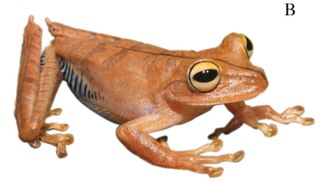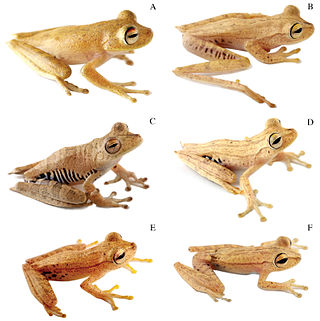Boana beckeri is a species of frog in the family Hylidae. It is endemic to Brazil and is only known from a handful of localities in southern Minas Gerais and adjacent northeastern São Paulo. The specific name beckeri honors Johann Becker, Brazilian zoologist who collected many of the types.

Boana xerophylla is a species of frog in the family Hylidae. It is found in northern Brazil, French Guiana, Guyana, Suriname, and Venezuela south of the Orinoco.
Boana latistriata is a species of frog in the family Hylidae. It is endemic to Brazil and only known from its type locality, Itatiaia National Park, and from Marmelópolis, both in the state of Minas Gerais. The specific name latistriata refers to the wide stripes on the back of this frog.

Scinax alter, the Crubixa snouted treefrog, is a species of frog in the family Hylidae endemic to Brazil.

Scinax tropicalia, or Tropicalia's snouted treefrog, is a frog. Scientists report two distinct populations, both in Atlantic forest in Brazil. It lives no more than 600 meters above sea level.
Scinax cabralensis is a frog in the family Hylidae. It is endemic to Brazil. Scientists observed some of these frogs 1070 meters above sea level.
Scinax montivagus is a frog in the family Hylidae. It is endemic to Brazil. It is known solely from its type locality in the Chapada Diamantina in the Espinhaço Range.
Scinax rossaferesae is a frog in the family Hylidae. It is endemic to Brazil and has been observed in the Guartelá Canyon area.
Boana cambui is a frog in the family Hylidae. It is endemic to Brazil. Scientists have seen it 905 meters above sea level.

Boana almendarizae, or Almendariz's tree frog, is a frog in the family Hylidae endemic to Ecuador. Scientists have seen it between 500 and 1950 meters above sea level in the Andes Mountains.
Sphaenorhynchus canga is a frog in the family Hylidae. It is endemic to Minas Gerais, Brazil.
Osteocephalus vilarsi is a frog in the family Hylidae endemic to the state of Amazonas in Brazil and the state of Amazonas in Venezuela. Scientists think it might also live in Colombia. This frog lives in white-sand forests.

The stained tree frog is a frog in the family Hylidae endemic to Ecuador, Colombia, and Peru. Scientists have seen it between 186 and 354 meters above sea level.
Boana stellae is a frog in the family Hylidae, endemic to Brazil. Scientists know it from the type locality: between 200 and 600 meters above sea level on the Araucaria plateau in Rio Grande do Sul.
Boana bandeirantes is a frog in the family Hylidae, endemic to Brazil. Scientists have seen it only over 400 meters above sea level.
Boana aguilari is a frog in the family Hylidae, endemic to Peru. Scientists have seen it between 1225 and 2080 meters above sea level.
The tepui tree frog is a frog in the family Hylidae, endemic to Brazil and Venezuela. Scientists have seen it between 420 and 1800 meters above sea level.
Dendropsophus reichlei is a frog in the family Hylidae endemic to Bolivia, Peru, and Brazil.
Nyctimantis pomba is a frog in the family Hylidae, endemic to Brazil. Scientists have seen it in exactly one place, 233 meters above sea level in the rainforest in Minas Gerais.

Pithecopus araguaius is a species of frog in the family Hylidae, endemic to Brazil. It has been observed in Mato Grasso. This frog has been observed 418 meters above sea level.






